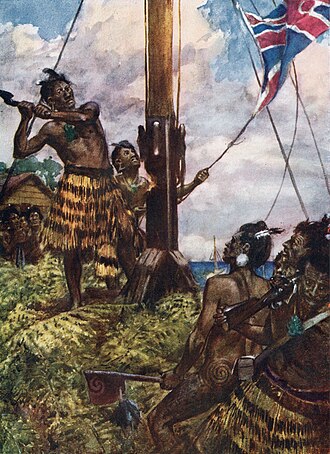
Commemoration of The New Zealand Wars
Hone Heke cuts down the flagstaff at Kororāreka.
In 2017, as a result of a petition by students of Ōtorohanga College the 28 October was declared a National Commemoration of The New Zealand Wars. Which personally gives me a little hope for the future, it shows young people in New Zealand can indeed change things and make a difference and that many of them honor the history of our country and what their ancestors endured. The church is choosing to observe this on the nearest Sunday.
Every European power in the late 18th Century was colonizing and taking over other lands. NOT a single one of them including Canada and the USA has clean hands when it comes to their governments treatment of indigenous native peoples. I have heard it said that the Missionaries would be the first contact indigenous people had with Europeans and would soften them up for the Colonizers coming behind them. The Missionaries did not intend this, they were brave men and women who left their homes at the call of Jesus and went, at risk of their lives, to bring the good news of the gospel and God's blessings to those living in spiritual darkness. Most missionaries had great love and respect for the native people they were trying to reach. New Zealand was one of the last places on earth reached because of it's isolation and the well earned fierce reputation of the Maori. The Missionaries, had become aware of the pattern, they were determined that in New Zealand it would be different, they wanted to protect the Maori. That is how the Treaty of Waitangi came about. They couldn't keep the colonizers from coming and they knew it, but they engineered the treaty to get the best deal they could with a European power, in an attempt to prevent the things that had happened in other countries.
The New Zealand Wars were the result of Britain breaking the Treaty. The Treaty the Maori Chiefs agreed to and signed, is written in Te Reo Maori and the trouble with it all hinged on the translation of one word, 'kawanatanga'! In the English translation it was written as 'sovereignty' but sovereignty in Te Reo is 'tino rangatiratanga', kawanatanga which was a new word means "governance", the chiefs never would have agreed to giving away sovereignty. What they agreed to was the English ruling their own people within New Zealand while they retained their sovereignty of their land and people. But it did effectively stop the British from taking the land by conquest at least temporarily ( and at that point had they tried they would have lost) so instead they later stole it illegally through the courts. The first incident occurred in the South Island in 1843, and the Governor at the time acknowledged the settlers were at fault. Then war broke out in Taranaki in 1860, when the Maori decided enough was enough! Read the History here.
The treatment of Maori as second-class citizens in their own country continued down through the 19th Century, most notably through the treatment and removal of their children by a racist and corrupt 'Child Protection Service'. Oranga Tamariki has changed names mulitple times over the years, but their tactics and cruelty don't change much. Despite this today we are one country, those of us coming from European ancestry having grown up with great respect for Maori culture and people, we proudly claim it as 'our collective heritage'. Government actions continue to cause division between Maori and Pakeha, but right from the time of the land wars many Pakeha (New Zealanders of European ancestry) have stood allied with Maori, seeing the injustice and unfairness of many government actions. Let us remember today and pray for our Nation!
 Welcome
Welcome Calendar
Calendar Today's Word
Today's Word Lauds
Lauds Terce
Terce Sext
Sext None
None Vespers
Vespers Compline
Compline Matins
Matins